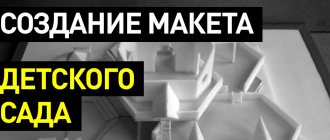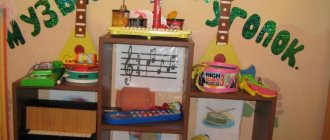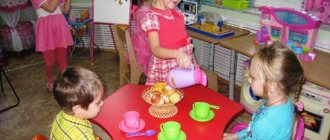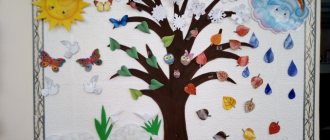- Where to begin?
- For boys
- Reception
Decorating a group room in a preschool institution for each teacher and parents becomes not just a responsibility, but also a creative process. It implements unique ideas and experiences, sometimes from several generations. In this article we will not only describe, but also place various corners in kindergarten in pictures. We hope that our site and this article will be useful to you. Well, let's get started.
Where to begin?
Before you start decorating a group in a kindergarten and creating various thematic corners in a kindergarten, you should definitely take care of the general decoration inside the group . When painting, you should not use a lot of bright colors. It is better if the tone of the main paint is light and “warm”:
- beige,
- peach,
- pearl and so on.
Photo wallpapers with characters from fairy tales and cartoons, as well as stickers with children's themes, look good in children's groups.
It is better to decorate all the group’s rooms in the same style and think in advance about a theme that will tie together the bedroom, reception area, study area and play corners in the kindergarten. Before you start designing specific corners, you should consult with your parents, discuss together and get acquainted with possible options for children of different ages. Here are some corners that can be organized in a kindergarten; for an example, see the photo.
Developmental environment
Play space
Traditionally, each group has a separate room for a bedroom, and the common group room is divided into an activity area and a play area. Play corners for kindergarten are designed differently depending on the age of the children in the group, free space and the creative scope of the organizer. For example, in the play area, a separate place is often allocated for a mummering corner in a kindergarten.
The location for it must be chosen with special care, it must be easily accessible and constantly open to children. The purpose of its design is to create conditions in the group for the creative activity of children, the development of imagination, the formation of gaming skills, the implementation of gaming plans, and the cultivation of friendly relationships between children. You can decorate such a place in the form of a model house, a stylist’s office, or a small screen with a variety of outfits:
- professions,
- animals,
- artists,
- fairy tale heroes and so on.
Once the location has been determined and the design option has been selected, you can begin the practical part. The boundaries of the corner are formed using furniture. This could be: a low rack with shelves, drawers and a crossbar for clothes hangers. For convenience, a table and chairs can be located in the corner. A mandatory attribute in the mummers' corner should be a mirror where children can examine and evaluate their appearance. You can paste pictures of various suits, hats and other items of clothing on the wall.

Design options
Sometimes a hairdresser’s corner in a kindergarten fits harmoniously into such a corner. Here everything is ready to equip the hairdresser’s workplace - a table, a chair for the client, a mirror. On the table you can put bottles, combs, hair decorations, etc. You can glue pictures of scissors and combs on the wall. The apron for the master can be located on one of the hangers on the crossbar.
If space allows, the hairdressing salon corner in the kindergarten is designed separately, as an independent area for the role-playing game “Barbershop”. First, the necessary furniture and shelves are also installed. Instead of a rack with outfits, you can place a bedside table or mini-wardrobe with hairdressing supplies. You can also sew wall pockets for them. Then game items are added. Usually such a place is made as a children's corner for a girl, based on an interest in hairstyles, jewelry, and so on.
Photo report “Subject-developmental environment in kindergarten”
Tatyana Kopystinskaya
Photo report “Subject-developmental environment in kindergarten”
A subject -spatial developmental environment is a set of conditions that have a direct and indirect impact on the comprehensive development of a child, the state of his mental and physical development, the success of further education at school, as well as on all participants in the educational process of a preschool organization.
The purpose of creating a subject -spatial development environment is to provide teachers with opportunities to develop the individuality of each child, taking into account his interests and level of development. The developmental environment must support the interests of each child and change along with his development.
In our kindergarten , in my mixed group (children from 3-7 years old, when creating a subject-developmental environment , we took into account the following principles: multifunctionality, periodicity, variability, richness, accessibility and safety.
I must say that we do not have a typical kindergarten , but a premise adapted for a kindergarten , the area is small, so every corner was used to create an environment .
Locker room: 1. Exhibition of children's fine art works . 2. Physical education corner (balls, skittles, jump ropes)
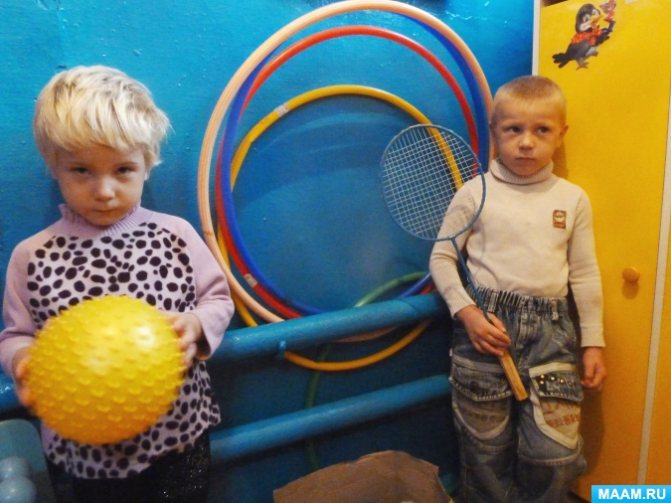
Group room:
1. Duty officer’s corner: aprons, headscarves and other accessories.
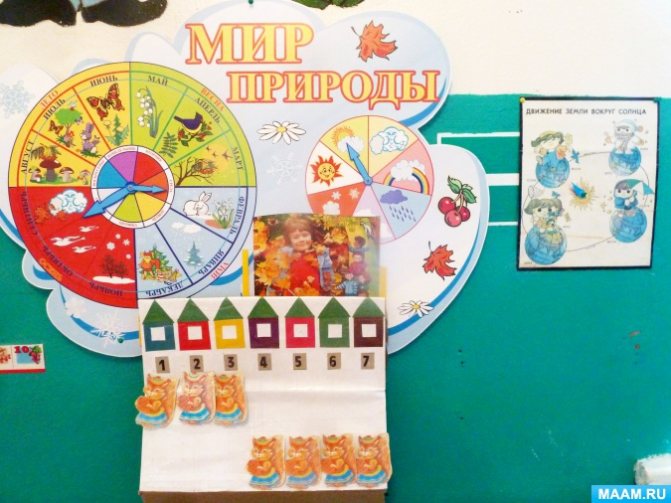
2.Nature corner: nature calendar; bottom shelf - natural material: pine cones, shells, acorns, sea pebbles, dry seeds and leaves.
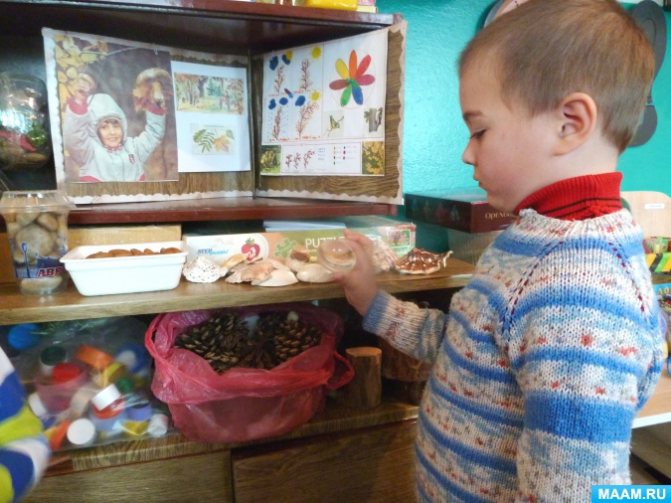
3. Shelf for experimentation: magnets, magnifying glasses, scales, salt, sugar, cereal.
4. Children's creativity :: for boys - tools for repairing toys, for girls - jewelry, bows, lace.
5. Corner for children. creativity easily moves into the corner of “Ryazhaniya” and theatrical activities, including finger theater.
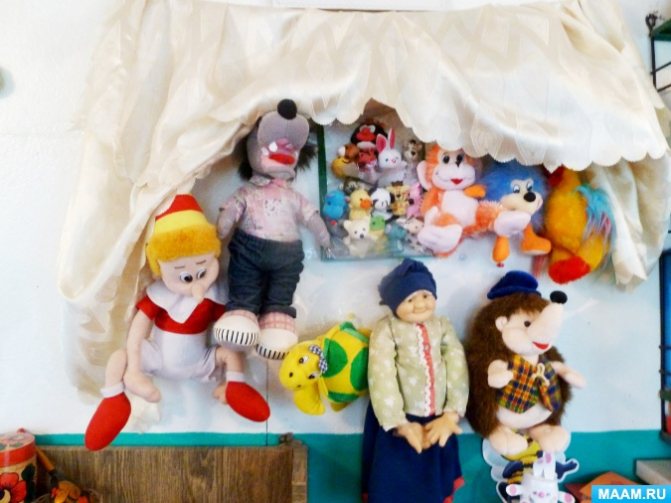
6. Fine art activity corner: plasticine, gouache, pencils, watercolors, felt-tip pens. Sets of illustrations of folk art, landscape artists, objects and crafts of folk craftsmen.
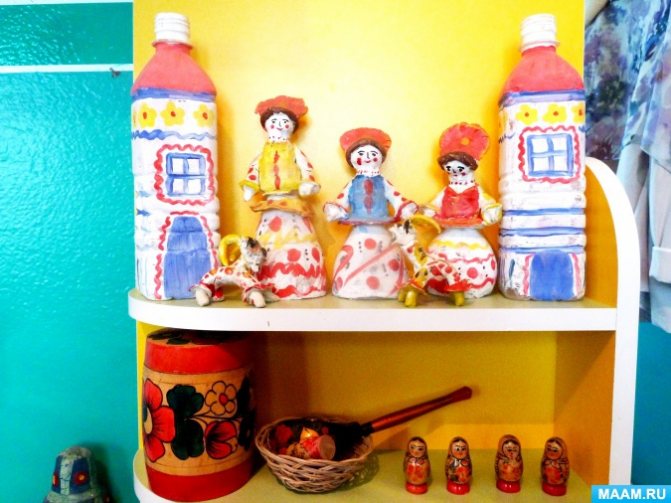
7. Book corner: publications about the animal and plant world, albums: “Our dear Army”, “Volgograd is a heroic city”, fairy tales of the peoples of the world. Didactic games: “Guess the fairy tale”, “Who lives where”, “In the animal world”
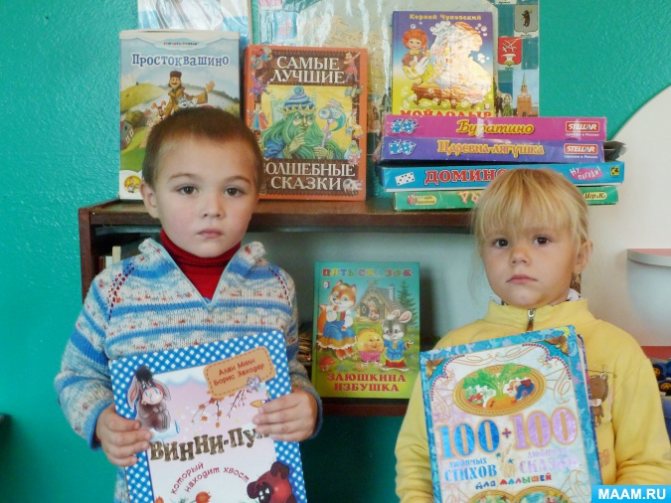
8. Role-playing game corner, here there are attributes for the games “Shop”, “Barbershop”, “Library”, “Hospital”
9. Corner “Knowledge”, here there is a “talking alphabet”, numbers, board and printed games “Geometric mosaic”, “Syllables”.
Construction corner: construction set “Highway”, “Lego”
10. Corner “Our country is Russia”; portrait of the president, flag, coat of arms, physical map of our country.
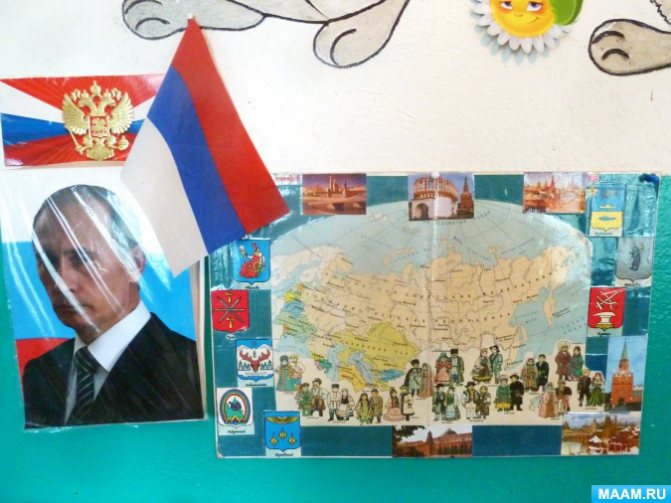
11. Traveler's Corner; map, globe, pictures depicting different types of transport, pictures depicting plants and animals of various natural zones. The “Traveller” corner easily transitions into the “Getting to Know Space” corner: map, starry sky, image of planets, album “Our Cosmonauts”
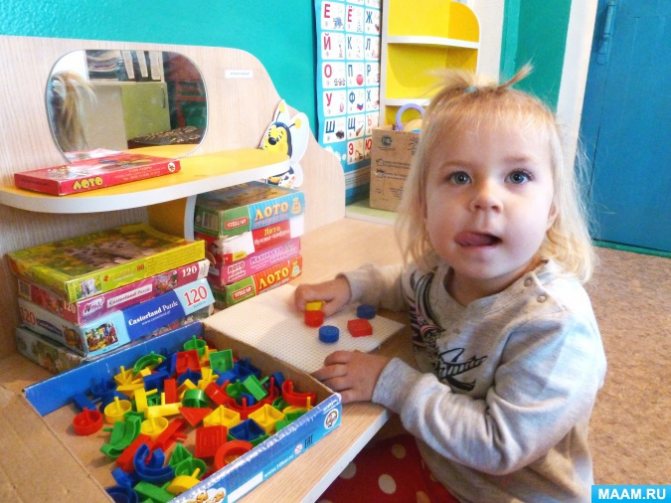
We are diligently working on mosaics.
For boys
However, there must be a place for boys to play in the play area. A children's corner for a boy may take up a little more space than for a girl. The main requirements for its location also remain convenience and accessibility for children. Such corners are created to take into account the gaming interests of children of different sexes, their differentiation and the development of gaming activities in general.
Design options are chosen based on the interests of the majority of boys in the group and general “boy” themes. For example:
- car showroom,
- nautical theme (ship),
- workshop,
- military base,
- or a corner of space in kindergarten.
Outer space will be interesting and useful for children of senior preschool age. With its help, children will gain basic knowledge about space, planets, and spaceships in a playful way.
The color scheme of such a corner is determined by the theme.
These are the shades:
- blue,
- purple,
- white and yellow colors.
It would be good if the furniture for the corner was made in the same colors. If the group’s budget does not allow you to buy new furniture, you can use self-adhesive film of the desired color and texture. On the floor you can place a rug with a space theme (lunar surface, meteorite). A simple model of the solar system must be present - either as a poster on the wall, or paper planets in volumetric form, hanging from the ceiling.

Color solution
What do you need to know about SanPiN in preschool institutions?
Sanitary and hygienic rules and regulations for preschool institutions are approved by SanPiN 2.4.1.3049-13.
The act, approved by the Decree of the Chief Sanitary Doctor of the Russian Federation dated May 15, 2013 No. 26, includes rules governing the organization of the organization and the rules for the use of accessories for children accepted into groups.
The act establishes requirements for:
- location of the preschool educational institution;
- equipment, including its location;
- maintenance of territories related to a children's educational institution;
- maintenance, decoration of premises, the building itself;
- lighting of rooms, as well as auxiliary premises (natural and artificial);
- heating, water supply, ventilation, sewerage and other systems;
- the formation of groups that accept children with diseases that limit their health;
- admission of minors to organizations implementing preschool education programs;
- organization of the regime and educational process, including training;
- equipment, inventory, toys, dishes and equipment in the catering department;
- conditions of preparation, storage of food, menu preparation;
- transportation, food intake;
- hygienic, anti-epidemic measures;
- compliance with sanitary standards.
All of the above requirements must be strictly observed by employees of preschool institutions.
For refusal to comply with the rules, citizens and organizations face a hefty fine. Next we will talk about labeling furniture and utensils in preschool educational institutions.
Reception
The locker room or reception area is the first thing a child and his parents see when they bring their child to kindergarten. Therefore, its design must be taken seriously. For children, there is usually a mood corner in kindergarten. The purpose of such a corner is to create a favorable emotional environment in the group. Thanks to it, children learn to understand not only their own mood, but also the mood of their peers.
In the design of such a corner, ready-made stands or home-made models can be used. The principle of their design is the same: in several pockets there are pictures with different emotions (their number depends on the age of the children), pockets for photographs of children are attached to the bottom. Coming to the group, the child, together with a parent or teacher, determines his mood and places his photo in the pocket under the corresponding emotion.
If the mood changes during the day, the photo is rearranged. Emotions can be depicted in the form of emoticons and cartoon characters. An approximate list in the older group could be: joy, fun, calm, surprise, sadness, anger.
note
It’s worth paying attention to the corner of the menu in kindergarten. The purpose of its creation is to familiarize parents with the child’s diet outside the home, as well as the basic principles of nutrition for preschool children. We can decorate it as a ready-made stand or manually (with painted pictures on the theme of the group, in the form of three-dimensional figures made of salt dough). Usually it has several pocket compartments. They contain a daily menu, as well as rules for feeding children.
Find out how to make a children's playground out of logs with your own hands in our material! You will learn how to properly make clothes for children in our article!
At https://karuselkin.ru/sad-i-shkola/kak-organizovat-i-provesti-detskij-novogodnij-utrennik/ link you will find interesting scenarios for the New Year.
If entering kindergarten is not an urgent problem, and you are just preparing to become parents, then you can beautifully decorate the room for your child by organizing children's corners for newborns. Usually they provide a sleeping place for the baby, a changing place and a place for clothes and toys. The colors of furniture and wallpaper should also be chosen soothing and light. You can paste a few funny pictures of children's toys. Soft toys are excluded in such a corner. So, the options for children's corners can be varied, the main thing is that they are aesthetically designed, safe and interesting for children.
Corner of cognitive and research activities in the senior group
Publications on the topic:
Work plan for the development of cognitive and research activities in the senior group September 1. Inanimate nature. Helper water. What are its properties? Program content: use knowledge about rising water levels to.
Photo report on cognitive research activities in the senior group. GCD “Properties of Air” Cognitive development. Cognitive research activities. Topic: “Properties of Air” Purpose: To expand children’s understanding of.
Summary of a lesson on cognitive-research activities in the senior group “Impressions of summer” Summary of educational activities in cognitive-research activities in the middle group on the topic “Impressions of summer” Program content: 1.
Abstract of educational activities in the senior group on the topic “Volcanic Eruption” Summary of educational activities in the senior group on the topic “Volcanic Eruption” Integration of educational areas:.
Abstract of educational activities for cognitive and research activities in the senior group “Magic Air” Purpose: Clarification and generalization of ideas about the properties and functions of air. Objectives: - contribute to the expansion of knowledge about air; - support.
Summary of educational activities for the development of cognitive and research activities in the senior group “History of the spring” Purpose: to introduce children to the history of the spring. (“Easy”) Objectives: Educational: To teach how to approach problems creatively and proactively.
Summary of educational and research activities with water in the senior group “Travel with a drop” Educator: Lukinykh Yu. G. Form of education: non-traditional lesson in research activities. Goal: improve performance.
Summary of a lesson on cognitive and research activities in the senior group Topic: Migratory birds. Goal: To consolidate quantitative and ordinal counting within 10; the ability to compare two groups of objects; Right.
Summary of a lesson on educational and research activities to study traffic rules in the senior group Equipment: map diagram (city route), mouse chips, layout of a traffic light, intersection, car, pedestrian crossing, 2 cords, 3 signal.
A lesson on cognitive and research activities “Healthy smile” in a senior group of different ages. Purpose of the lesson: to give children the information necessary to improve their health; develop the necessary hygiene measures based on the knowledge gained.
